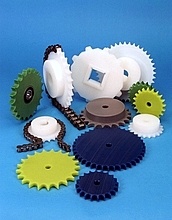 Unlike metals or ceramics, plastics are viscoelastic materials – that is, they respond to stress as if they’re a combination of a viscous fluid and a plastic solid. In other words, while plastics have solid-related characteristics such as stability of form, strength — and, yes, elasticity — they also possess fluid-like properties such as flow, which can be affected by temperature, rate, and time as well as the amount of loading.
Unlike metals or ceramics, plastics are viscoelastic materials – that is, they respond to stress as if they’re a combination of a viscous fluid and a plastic solid. In other words, while plastics have solid-related characteristics such as stability of form, strength — and, yes, elasticity — they also possess fluid-like properties such as flow, which can be affected by temperature, rate, and time as well as the amount of loading.
For designers and engineers used to working with metals and ceramics, plastics can be tricky – they don’t exhibit a linear stress/strain relationship. As a result, designers working with plastics for the first time often select and specify the wrong plastic materials for their applications. This unfamiliar non-linear relationship makes it vital for designers to understand stress relaxation, creep, and fatigue properties of plastic.
As a result of the fundamental differences between metals, ceramics, and plastics, it is not uncommon for failures to occur because the wrong plastic was selected for a particular application or product. Applications that require high-impact resistance require a high-impact plastic. Likewise, plastics to be used in outdoor applications must be ultra-violet (UV) resistant to maintain their strength after being exposed to the sun for certain periods of time.
It’s important to remember that proper plastic material selection starts with carefully defining all the necessary mechanical, thermal, environmental and chemical requirements. Add in special considerations such as outdoor UV exposure, fatigue, creep, stress relaxation, light transmission and even regulatory requirements. One of the most important considerations is chemical exposure as many plastics are susceptible to attack and degradation by chemicals.
So what should a product design engineer do to ensure he or she selects the right plastic material? Start by looking at plastic material data sheets. These are useful for comparing property values such as tensile strength of nylon versus polycarbonate or the impact strength of polystyrene as compared to ABS. For example, if you’re a designer looking for a strong and tough plastic, start with plastics with at least 7000 psi tensile strength and impact values greater than 1.0 ft-lb/in. A word of caution, though. Data sheets are essentially sales tools provided by manufacturers and are never meant to be relied upon for final engineering decisions and plastic material selection. The data used in them is generally obtained from short-term tests and cannot not be considered accurate for long-term use unless specifically indicated. Instead, all considerations must be taken into account such as type of fabrication, any secondary operations, component assembly and, of course, cost.
Some high-impact plastic materials include:
- Polycarbonate
- Polyethylene
- Nylon
- Polypropylene
- Polyvinylchloride (PVC)
- Polyphenylsulfone
- Ethylene-tetrafluoroethylene
- Polyamide-imide
Pages 44 – 46 in the new Slideways SW 15 catalog provide handy material compatibility and properties information. Also included are the FDA, USDA, 3A dairy acceptance indications as well as other engineering data.


